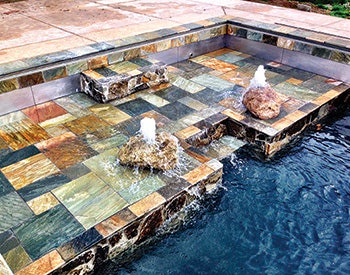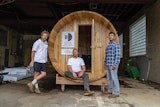Pools by their vary nature are both artistic and functional. The reflective aspect of water coupled with the materials that contain and surround it offers a creative interface that has defined the work of designers working in aquatic spaces for centuries.
As I’ve developed my own business building pools, I’ve become more and more inspired to gravitate toward the artistic side of the equation. Although those instincts have always been in my mind, it was a project that features truly creative stonework that permanently tipped my work toward creating environments that rise to the level of sculptural art.
I built that pool for my friend Charles Powell, a high-end mason; he does a lot of work that’s extremely artistic, so it wasn’t a big surprise that he wanted his own project to reflect those creative instincts. I built him this hybrid stainless-steel pool, and he himself took part in the installation by employing his rockwork expertise. Seeing what he’s done, and continues to do as the project expands over time, furthered my own ambitions to make art.
 The chocolate quartz used on this sun shelf provides a vivid palette of rich earth tones that could never be achieved with man-made materials. Click to enlarge
The chocolate quartz used on this sun shelf provides a vivid palette of rich earth tones that could never be achieved with man-made materials. Click to enlarge
 A close look at how the sun shelf appears with water. Click to enlarge.
A close look at how the sun shelf appears with water. Click to enlarge.
One of the features was this wedding-cake step treatment pictured at the top of this story. We discussed various ideas for the step, one of which was to include this unusual pebble treatment, which resembles a stone mosaic more than a standard pebble surface. To create it, we went to a local landscape supply outlet and bought these polychromatic pebbles, and Charles went to work setting each stone by hand, a process that took three or four days.
In addition to the step area, we now have beautiful stone coping that serves as a complement. The long-term plan is take the rockwork on the steps and create a ribbon of the material that will run across the deck and lead to an outdoor fireplace.
This experience in seeing the potential of stonework has inspired me in my own work, particularly right now, as I’m building my own pool and now plan to have about 80 percent of the pool covered in that same type of material pebble material.
A NATURAL ASSIST
Charles is a wonder at what he does; I watched him as he carefully considered the selection and placement of each and every rock, the culmination of which is a stunning rock candy-like mosaic. Not only did the rock treatment transform one of the more ordinary aspects of the project into a visual spectacle, it also made for a perfect non-slip surface on the steps. It’s both beautiful and functional.
Continuing with the natural stone motif, the stone copping is quartzite, slightly cantilevered, and the plan now is to do some type of quartz tile to match. The coping pieces were selected individually from multiple palettes, so every stone is part of an overall artistic composition.
When we started on this project, it was the first I’d done with this level of custom stone applications. Since then, some form of stone treatment has come up on a majority of projects. For example, we just finished a project with a wonderful, chocolate-colored quartz sun shelf. In that case, we even formulated our own grout with Hydrazzo so we could carry grout material down into the pool finish.
However, quartzite is extremely hard and difficult to cut, which makes it challenging to install. That same hardness, however, is what makes it resistant to damage in the presence of water. But with the rain and freezing weather you often find in Oregon, it makes for a hardy material that holds up against various water conditions.
We also add a layer of insurance by using chemical sealers on all stone that comes in contact with the water. Of course, there’s no question some types of stone are more susceptible to deterioration in the presence of water than others, so it’s always important to select a suitable material.
Not only is quartzite durable, there’s also a huge variety of colors and veining that can be used across a range of designs. It’s the kind of material that can transform a relatively ordinary design into something exciting and unique.
As I’ve moved further and further into using stone, it’s changed the way I think about taking advantage of natural materials. For example, while doing the excavation on a pool I’m working on in Washington, we ran into a layer of cobble. It has an interesting mix of caramel, white and red veins. We pulled about a dump-truck full of the material, but rather than simply discard it as spoils, we’ve decided to screen and wash the material and use it in the project, where it’ll serve as a pebble creek connecting the raised spa to the pool.
NATURAL INCLINATIONS
To my mind, that’s a great way to tie the work into the natural environment, to show a type of reverence for nature in what is otherwise a distinctly man-made environment. These days, I’m always on the lookout for material we can use to add value and interest to the design.
 Vibrant colors and irregular shapes of the flagstone are enhanced by the color and texture of the grout material. Click to enlarge.
Vibrant colors and irregular shapes of the flagstone are enhanced by the color and texture of the grout material. Click to enlarge.
On the pool I’m building for myself, for example, we’re going to use flat boulders along the edge, eliminating the waterline tile and letting the rocks extend down into the water about a foot or so. It’ll function like a natural type of coping and hopefully give the pool a measure of naturalism, which will work beautifully with our verdant surroundings.
In a situation that involves adding so much weight at the top of the structure, we’re increasing the weight-bearing capacity of the structure with a foot-thick, heavily steel reinforced shelf. Obviously, no one wants to see the stone break off down the line because the shell couldn’t handle the weight. The pool has to be designed to hold up its own weight and withstand the soil conditions.
Earlier this year, AQUA ran a story about my relationship with my dad, who built pools for 40-plus years. During his career, my dad did some terrific work with natural stone, but kind of moved away from that, so my evolution back into the material is a bit of a full circle. In practical terms, he was always working to exceed the structural requirements, and seeing how well his work has endured through the years, I’ve stuck with that philosophy, which in my view is a big help when you start using stone and adding weight to the structure.
When we’re dealing with architectural stone, the weight issue isn’t as significant as it is with boulders, although you still should take the weight into consideration. It’s also critical to work with material that is sized properly for the installation. Generally speaking, stone is more irregular than tile, bricks or pavers. That can mean you’re paying close attention to every square inch so that it appears consistent.
THE CUTTING EDGE
For example, for the project I mentioned above using the chocolate quartzite, we went through $500 worth of diamond blades cutting the stone for just two 36-inch tall columns. That’s a fairly large cost for such a relatively small amount of stone and a tremendous amount of effort.
We also don’t want sharp edges or irregular surfaces that can create a trip hazard. With tile, you can buy bullnose pieces or quarter rounds. With stone, those special pieces aren’t generally available, so you have to work the edges by hand. Because stone can be difficult to cut, you want to find pieces that fit the application, and that means finding the right supplier.
 The clever use of stone adds a timeless quality to traditional architectural and ornamental forms. Click to enlarge.
The clever use of stone adds a timeless quality to traditional architectural and ornamental forms. Click to enlarge.
Although we are open to working with suppliers that are not local, finding a source that doesn’t require the expense of long-distance shipping is crucial in keeping costs down to a reasonable level. Having a great resource on your doorstep is a huge plus.
Using stone has led me to regard the process of building pools as more of an art than just a type of construction. My dad used to build very similar looking pools over and over again, and while I learned a great deal about doing quality work and standing behind that work, frankly I’ve grown weary of building the same rectangular vinyl liner or gunite pool.
With stone, every project is unique because every piece of stone is different. The result is the work becomes far more personalized for the client and they take pride in owning something that no one else has, or will ever have, because the material will always have its own character and subtle or even dramatic variations.
When you use the power of nature to infuse your work with variation and individuality, even the most straightforward pools can become something very special – so much so that when done with care and creativity, they do truly become works of art.
Comments or thoughts on this article? Please e-mail [email protected].











































